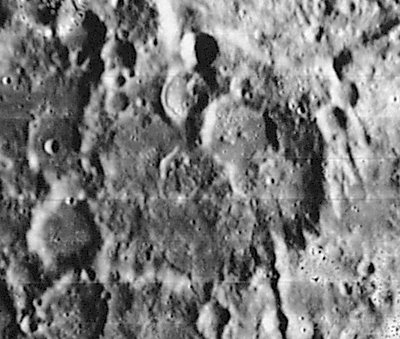Parrot
Contents
[hide]Parrot
|
Lat: 14.5°S, Long: 3.3°E, Diam: 70 km, Depth: 2.08 km, Rükl 55 |

LOIV 101 H2 Parrot is the large irregular formation in the middle of this frame. The round half-shadowed crater at top center is Parrot R. The larger crater to its southeast, on the floor of Parrot, is Parrot D. The two equally large craters in the lower left corner are Parrot A (top) and Parrot E (bottom).
Images
LPOD Photo Gallery Lunar Orbiter Images Apollo Images
- Is the half-submerged crater with the double western rim overlapping the north part of Parrot in the Lunar Orbiter 4 photograph a concentric crater? (see the high-resolution scan of LO-IV 101H2 and the annotated image by John Moore). Research: Danny Caes
Maps
(LAC zone 77C4) LAC map Geologic map LM map USGS Digital Atlas
Description
Description: Elger
(IAU Directions) PARROT.--An irregularly-shaped formation, 41 miles in diameter, S. of Albategnius, with a very discontinuous margin, interrupted on every side by gaps and depressions, large and small; the most considerable of which is the regular ring-plain Parrot a, on the W. An especially fine valley, shown by Schmidt to consist in part of large inosculating craters, cuts through the wall on the S.E., and runs on the W. side of Argelander towards Airy. The floor of Parrot is very rugged.
Description: Wikipedia
Additional Information
*Depth data from Kurt Fisher database
- Westfall, 2000: 2.08 km
- Cherrington, 1969: 1.09 km
- Central peak height
- Sekiguchi, 1972: 0.6 km - fatastronomer
- The half-submerged crater immediately south of the bowl-shaped crater Parrot R and west-northwest of Parrot D (at the northern half of Parrot itself) has a curious double western rim. Another such "double rim" is noticeable near the lower left corner of Lunar Orbiter 4 frame 163-h3 (northwest of Louville D, at Sinus Roris). A farside example of this kind of "double rim" is the crater south of Dugan. - DannyCaes Aug 7, 2015
- The valley-like "groove" at the south-southeastern part of Parrot is part of the Imbrium sculpture. - DannyCaes Jun 1, 2009
Nomenclature
- Named for Johann Jacob Friedrich Wilhelm Parrot (1792-1840), a Baltic German doctor, physicist, naturalist and traveller. He studied medicine and natural science. He used a barometer to measure the difference in sea level between the Caspian Sea and Black Sea. In 1857 he went to Tornio in northern Finland to observe oscillations of a pendulum and terrestrial magnetism. He invented a gasometer and a baro-thermometer.
- Parrot C, a crater east of Arzachel, was given the name Muller (Karl Müller) by Felix Chemla Lamech. The I.A.U. did not accept this suggest, and used Müller for a crater the centre of the Albategnius-Hipparchus-Ptolemaeus triangle (research Ewen A. Whitaker and Danny Caes; August 2003 mail correspondence).
- Parrot C was also once named Millas by Hugh Percy Wilkins but the I.A.U. did not accept his name. Jose Maria Millas Vallicrosa was a Spanish philosopher (research: Danny Caes and Claude Libert using The Moon by Wilkins and Moore).
- There is an unnamed valley-like "groove" at the south-southeastern part of Parrot. - DannyCaes Sep 1, 2015
Loro Basin, and an unknown swirl
- The flat area east-southeast of Parrot C and west-southwest of Airy is unofficially labeled Loro Basin on the greenish Rand McNally moonmap and on the same map in Patrick Moore's Atlas of the Universe. The exact origin of the name Loro Basin is still unknown (who was Loro?). This Basin is also the location of one of the most unknown swirl formations; only detectable during observations of the Full Moon! See the LROC's close-up of it: http://bit.ly/2onSr9A
- See list of other mysterious names on the Rand McNally moonmap. - DannyCaes Sep 1, 2015
LPOD Articles
Bibliography